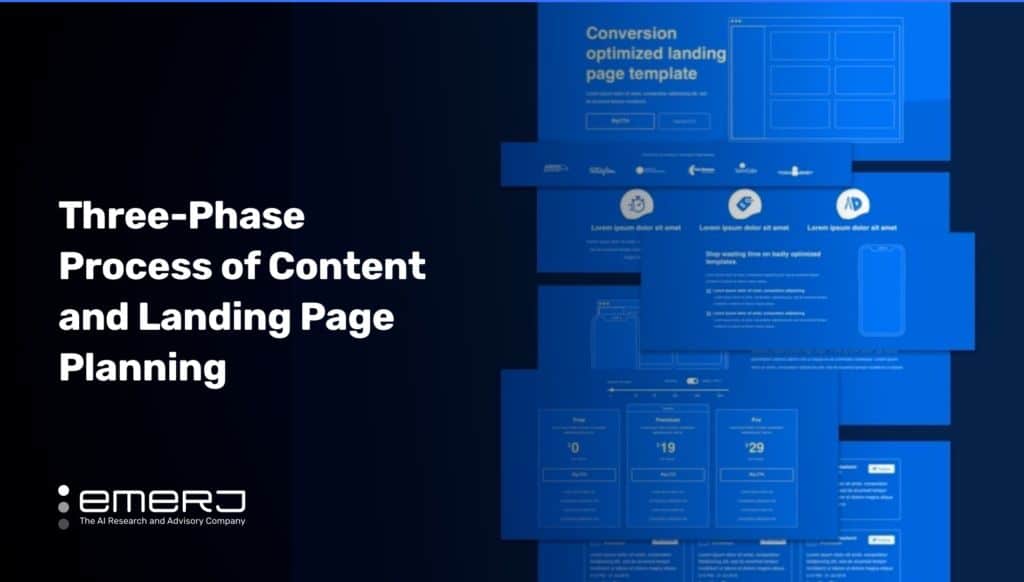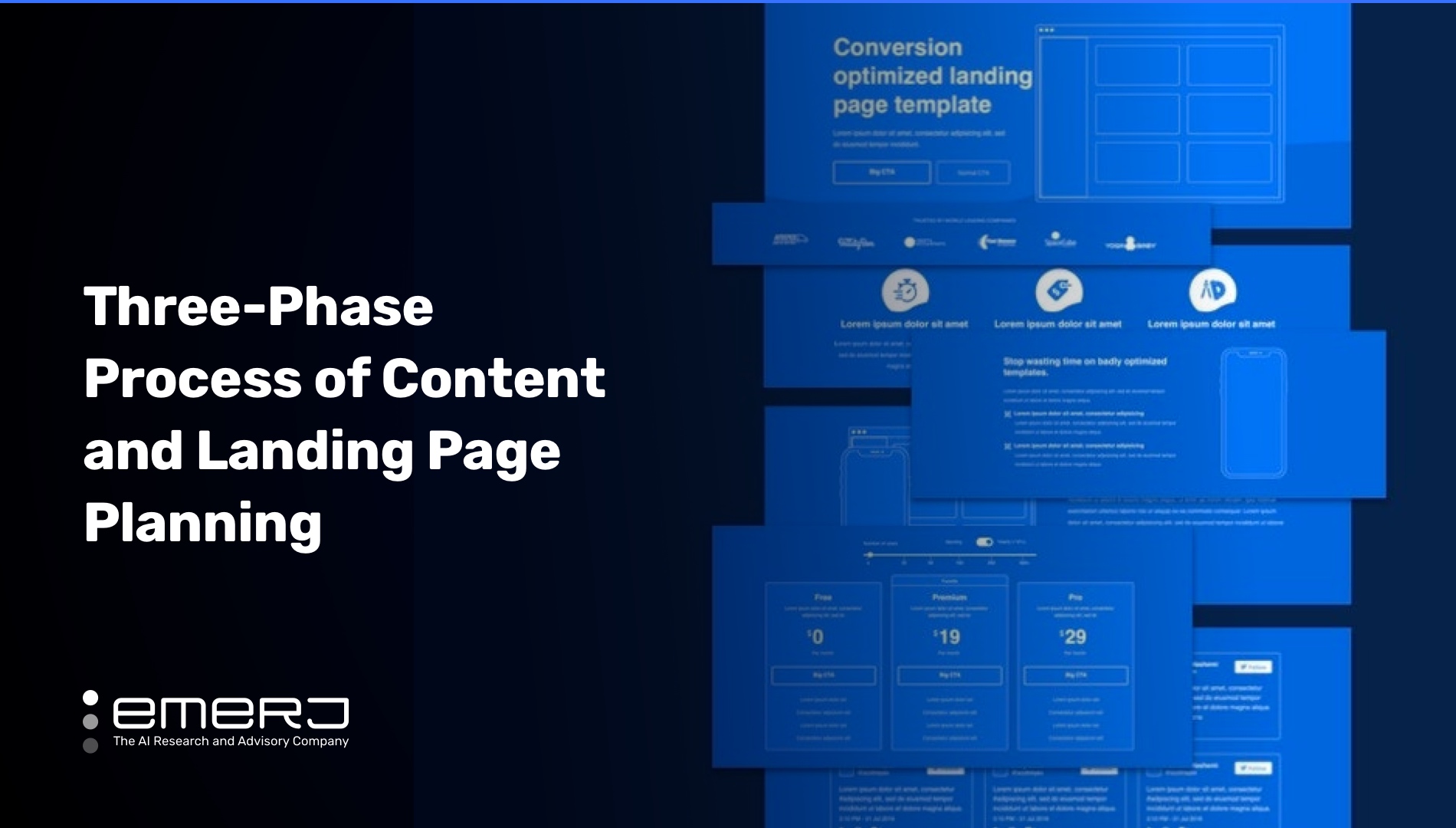
Writing content to attract B2B prospects begins with an understanding of the problems that your prospect is facing, and the solutions that your prospect is most likely to be looking for.
We break this process down with clients into the steps below. To provide examples for this process, we’ll respond to the questions and prompts of the process as if we are an AI healthcare operations vendor.
For the sake of this example, we’ll presume that our product offers hospitals a better way to schedule appointments, manage appointment inventory, and collect funds from our patients.
When we go through the three phases (below) with clients, we usually prefer to do so with multiple stakeholders in the room.
Sales staff often understand best what convinces buyers to buy. Marketers often understand what they want their product to be known or found for. Also, it is occasionally necessary to have product people available who can shed light on what the product can or cannot do.
While most of the work is done with marketing teams, input from sales and product gives the marketing team the confidence that they’re not missing any important ideas.
Below, we’ll walk through all three phases of content and landing page planning:
Phase 1 – Landing Page Offer Determination (“Gateways to Rome”)
Determine your core top-of-funnel and middle-of-funnel landing page offers by finding the intersection between:
- The most pressing problems
- The value of your product or service as it pertains to those problems
These core landing page offers will serve as your most important lead generation assets and will form the basis of a much larger content strategy.
These initial landing page offers could take the form of almost any medium (webinar, guide, research, etc.). What matters most is that they directly address the most pressing problems in the minds of your customers.
If you have proven core messages you can exploit, they should be immediately translated into one or more landing pages (white papers, webinars, whatever medium you believe will convert well). As mentioned earlier in section 2.5 above, these hard-won, proven messages should be turned into gravity assets (highly visible, highly credible PDF resources that cement your core message).
If you don’t have a proven core message yet, or you’re exploring beyond this message, then determine a small set (we generally recommend no more than 2-3) of explore-able market messages and set up download pages for those that you believe to be the most promising and that make the best use of your limited go-to-market testing efforts. Be absolutely deliberate.
In our “all roads lead to Rome” B2B marketing philosophy, content, and media effort should all serve to:
- Reinforce a core brand message (preferably a proven core message, but at least a well-reasoned exploratory message that touches on attention-oriented themes), i.e., what we want to be known for, and to whom.
- Drive potential prospects towards an opportunity to provide their contact information to learn more from our firm, i.e. the first step in their journey to becoming a customer.
Lead generation opt-in pages – sometimes called squeeze pages – are gateways to Rome. They are your future roads (media, content, marketing efforts).
Phase 2 – Content Ideation
Once you know which lead generation resources you’ll be driving towards, your responsibility is to create a plethora of attractive, useful content topics that will drive prospects towards your core opt-in landing pages.
These ideas can be translated into any kind of content medium, from videos to podcasts to articles and more. More important than medium (which we’ll discuss in Phase 3 below) is message.
We recommend that clients think through questions in order to develop a wide array of content topics and titles to work with, which can later be prioritized and mapped out into a content calendar during Phase 3.
Below are some of the questions to get you started:
Question 1: What are the biggest problems your prospects are struggling with now? What are the various ways these problems might be worded?
Example:
- Hospital executives are dealing with shrinking profits and are eager to find more efficiencies.
- Hospital executives want to handle their staff and appointment-flows more effectively.
Question 2: What kinds of questions or terms do they input into search engines in order to deal with the problem?
Examples:
- “Healthcare process improvement”
- “Patient billing software”
- “Revenue cycle management”
- “RPA in healthcare”
- “Patient booking software for hospitals”
Question 3: What are the core opportunities that you help clients take advantage of?
Examples:
- Scaling collections and appointments without scaling staff
- Improving efficiencies and reducing costs
- Improving revenue collection in less time with less effort
Make note that some “opportunities” are merely different wordings of “problems.” In other cases, opportunities address something that most “problem” wordings don’t get to. In either case, this question is a useful exercise in developing terms and phrases for marketing material – and for determining potential content topics.
Question 4: What kinds of questions or terms do they input into search engines in order to take advantage of this opportunity?
Examples:
- “How to improve hospital revenues”
- “How to reduce operational costs in hospitals”
Question 5: When qualified prospects come and find us – what was their motivation to connect?
Examples:
- C-level healthcare leaders were motivated to connect due to frustration with existing solution providers, usually large incumbents like [example] or [example]
- Healthcare leaders are looking to save on the time and process costs of revenue recovery
What are the core problems that you help clients solve?
Question 6: What are the known methods of solving the client’s problems? What are the options they are considering?
Example:
- Problem 1: Manual healthcare collections efforts are inefficient and time-consuming. Calling or emailing individual patients or following up with insurance companies is an endless task, and prioritizing such follow-up is challenging.
- Solutions:
- Outsourcing phone calls and email follow-up to overseas providers reduces cost
- Purchase a solution from XYZ, an established revenue lifecycle software company
- Build a metrics dashboard and train internal staff on current best practices of follow-up and process management
- Solutions:
- This exercise can and should be repeated for the top 2-3 problems plaguing our target prospect. Ensure that the “solutions” you find are in fact what your prospects are doing now to solve this problem – rather than presumed solutions. Each of these problems and solutions can be its own content topic across any media type.
Note: You may have multiple stakeholder groups. For example, an AI vendor selling to banks may need to sell to IT leaders, COOs, and leaders in compliance and fraud.
It may be necessary to go through Phase 1 multiple times, once for each stakeholder type (as each stakeholder likely has vastly different motives for buying).
Phase 3 – Determine Content Cadence (and “Roads to Rome”)
From here, you’ll want to develop a content cadence that you can commit to.
This content will almost always involve the following core ingredients:
- Social posting schedule
- Blog posts and articles
- Regular email newsletters
…but may also include:
- Guest blog/column writing
- Earned media – a cadence of outreach to journalists, podcasts, or other media outlets that may want to cover your story
- Video content
- Podcast episodes
- Infographics
- Etc…
We recommend a bare minimum of one email newsletter every two weeks, one social post per day (on whichever accounts your firm is active on, LinkedIn and Twitter are most common), and one article between 800-2,000 words published per week.
Whatever cadence you can commit to, each piece of content should deliberately explore a potential message or exploit a proven message – generally with over 50% focused on exploiting what we know to be working.
In our “all roads lead to Rome” philosophy, your “roads” are the ways that you connect your content (which is based on topics deliberately selected to resonate with the exploit or explore market messages for which you have landing pages) to your opt-in landing pages themselves.
While it’s obvious that landing pages should be used in direct marketing efforts (social, retargeting, paid editorial, etc.), landing pages should also become part of the content and communication ecosystem of your company.
While there are dozens of potential ways to integrate landing pages into a company’s content or communication, we consider the following landing page placement ideas as mandatory:
- Next to all relevant written content. For content related to a marketing message, have a sidebar, footer, or potentially a banner featuring an opt-in resource related to that same market message.
For example:
- An article titled “5 ways to streamline the contract review process in the enterprise” (intended to attract in-house enterprise legal leadership) may have a PDF resource featured in a banner or placement on the side or bottom of the article, titled: “How to Unlock Efficiencies and Reduce Risk – A Guide for In-House Counsel Leaders.”
- Next to all relevant multimedia content. YouTube videos, podcasts, or socially shared images (Pinterest, Instagram, etc.) should not only link back to your brand’s homepage, but should naturally direct users to the opt-in landing page most closely related to the theme of the video.
- Mentioned directly in earned media. From guest articles, to industry speaking events, to being a podcast or radio guest – marketers should focus not only on mentioning their brain and their value proposition, but should also be gently guiding readers or listeners to the most relevant landing page.
For example:
- An eCommerce AI-based recommendation vendor company might have a variety of landing pages, with topics ranging from reducing customer churn to improving cart value for apparel retailers. If the CEO of this vendor is a featured guest on a podcast for apparel retail marketing leaders, he or she might directly mention their own PDF guide for unlocking apparel retail revenues with recommendations – rather than simply mentioning the company brand name or homepage.
Why Should Clients Trust You to Take Them to Rome?
Before you write content for your landing page, it’s important to have a well-reasoned strategy that guides your approach. A thoroughly researched landing page will help you attract B2B prospects by showing that you understand the problems they face and the solutions they need.
Include the right people in the discussion when you brainstorm, draft, and finalize your content, and follow industry best practices in designing the landing page. By making clear your landing page offers, ideating relevant and engaging content, and determining the right content cadence, you can lead the right B2B prospects to your value proposition and convince them that you are the right firm to take them to the “Gateways of Rome.”


















